陕西科技大学:《包装技术基础 Fundamentals of Packaging Technology》课程PPT教学课件(英文版)Lesson 11 Package Printing 第11课 包装印刷
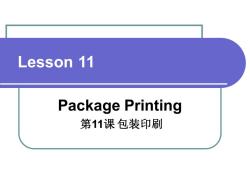
Lesson 11 Package Printing 第11课 包装印刷
Lesson 11 Package Printing 第11课 包装印刷
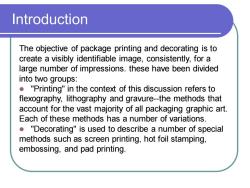
Introduction The objective of package printing and decorating is to create a visibly identifiable image, consistently, for a large number of impressions. these have been divided into two groups: ⚫ "Printing" in the context of this discussion refers to flexography, lithography and gravure-the methods that account for the vast majority of all packaging graphic art. Each of these methods has a number of variations. ⚫ "Decorating" is used to describe a number of special methods such as screen printing, hot foil stamping, embossing, and pad printing
Introduction The objective of package printing and decorating is to create a visibly identifiable image, consistently, for a large number of impressions. these have been divided into two groups: ⚫ "Printing" in the context of this discussion refers to flexography, lithography and gravure-the methods that account for the vast majority of all packaging graphic art. Each of these methods has a number of variations. ⚫ "Decorating" is used to describe a number of special methods such as screen printing, hot foil stamping, embossing, and pad printing
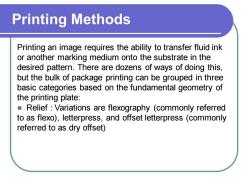
Printing Methods Printing an image requires the ability to transfer fluid ink or another marking medium onto the substrate in the desired pattern. There are dozens of ways of doing this, but the bulk of package printing can be grouped in three basic categories based on the fundamental geometry of the printing plate: ⚫ Relief : Variations are flexography (commonly referred to as flexo), letterpress, and offset letterpress (commonly referred to as dry offset)
Printing Methods Printing an image requires the ability to transfer fluid ink or another marking medium onto the substrate in the desired pattern. There are dozens of ways of doing this, but the bulk of package printing can be grouped in three basic categories based on the fundamental geometry of the printing plate: ⚫ Relief : Variations are flexography (commonly referred to as flexo), letterpress, and offset letterpress (commonly referred to as dry offset)
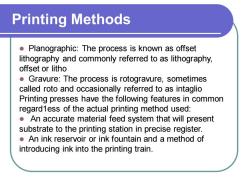
Printing Methods ⚫ Planographic: The process is known as offset lithography and commonly referred to as lithography, offset or litho ⚫ Gravure: The process is rotogravure, sometimes called roto and occasionally referred to as intaglio Printing presses have the following features in common regard1ess of the actual printing method used: ⚫ An accurate material feed system that will present substrate to the printing station in precise register. ⚫ An ink reservoir or ink fountain and a method of introducing ink into the printing train
Printing Methods ⚫ Planographic: The process is known as offset lithography and commonly referred to as lithography, offset or litho ⚫ Gravure: The process is rotogravure, sometimes called roto and occasionally referred to as intaglio Printing presses have the following features in common regard1ess of the actual printing method used: ⚫ An accurate material feed system that will present substrate to the printing station in precise register. ⚫ An ink reservoir or ink fountain and a method of introducing ink into the printing train
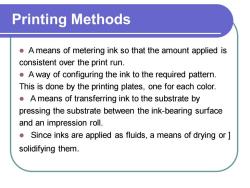
Printing Methods ⚫ A means of metering ink so that the amount applied is consistent over the print run. ⚫ A way of configuring the ink to the required pattern. This is done by the printing plates, one for each color. ⚫ A means of transferring ink to the substrate by pressing the substrate between the ink-bearing surface and an impression roll. ⚫ Since inks are applied as fluids, a means of drying or ] solidifying them
Printing Methods ⚫ A means of metering ink so that the amount applied is consistent over the print run. ⚫ A way of configuring the ink to the required pattern. This is done by the printing plates, one for each color. ⚫ A means of transferring ink to the substrate by pressing the substrate between the ink-bearing surface and an impression roll. ⚫ Since inks are applied as fluids, a means of drying or ] solidifying them
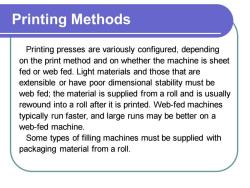
Printing Methods Printing presses are variously configured, depending on the print method and on whether the machine is sheet fed or web fed. Light materials and those that are extensible or have poor dimensional stability must be web fed; the material is supplied from a roll and is usually rewound into a roll after it is printed. Web-fed machines typically run faster, and large runs may be better on a web-fed machine. Some types of filling machines must be supplied with packaging material from a roll
Printing Methods Printing presses are variously configured, depending on the print method and on whether the machine is sheet fed or web fed. Light materials and those that are extensible or have poor dimensional stability must be web fed; the material is supplied from a roll and is usually rewound into a roll after it is printed. Web-fed machines typically run faster, and large runs may be better on a web-fed machine. Some types of filling machines must be supplied with packaging material from a roll
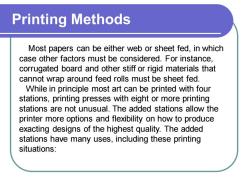
Printing Methods Most papers can be either web or sheet fed, in which case other factors must be considered. For instance, corrugated board and other stiff or rigid materials that cannot wrap around feed rolls must be sheet fed. While in principle most art can be printed with four stations, printing presses with eight or more printing stations are not unusual. The added stations allow the printer more options and flexibility on how to produce exacting designs of the highest quality. The added stations have many uses, including these printing situations:
Printing Methods Most papers can be either web or sheet fed, in which case other factors must be considered. For instance, corrugated board and other stiff or rigid materials that cannot wrap around feed rolls must be sheet fed. While in principle most art can be printed with four stations, printing presses with eight or more printing stations are not unusual. The added stations allow the printer more options and flexibility on how to produce exacting designs of the highest quality. The added stations have many uses, including these printing situations:
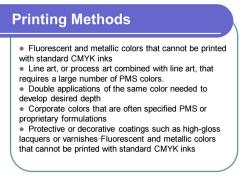
Printing Methods ⚫ Fluorescent and metallic colors that cannot be printed with standard CMYK inks ⚫ Line art, or process art combined with line art, that requires a large number of PMS colors. ⚫ Double applications of the same color needed to develop desired depth ⚫ Corporate colors that are often specified PMS or proprietary formulations ⚫ Protective or decorative coatings such as high-gloss lacquers or varnishes·Fluorescent and metallic colors that cannot be printed with standard CMYK inks
Printing Methods ⚫ Fluorescent and metallic colors that cannot be printed with standard CMYK inks ⚫ Line art, or process art combined with line art, that requires a large number of PMS colors. ⚫ Double applications of the same color needed to develop desired depth ⚫ Corporate colors that are often specified PMS or proprietary formulations ⚫ Protective or decorative coatings such as high-gloss lacquers or varnishes·Fluorescent and metallic colors that cannot be printed with standard CMYK inks
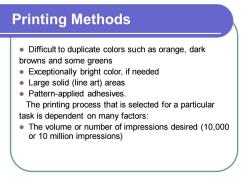
Printing Methods ⚫ Difficult to duplicate colors such as orange, dark browns and some greens ⚫ Exceptionally bright color, if needed ⚫ Large solid (line art) areas ⚫ Pattern-applied adhesives. The printing process that is selected for a particular task is dependent on many factors: ⚫ The volume or number of impressions desired (10,000 or 10 million impressions)
Printing Methods ⚫ Difficult to duplicate colors such as orange, dark browns and some greens ⚫ Exceptionally bright color, if needed ⚫ Large solid (line art) areas ⚫ Pattern-applied adhesives. The printing process that is selected for a particular task is dependent on many factors: ⚫ The volume or number of impressions desired (10,000 or 10 million impressions)
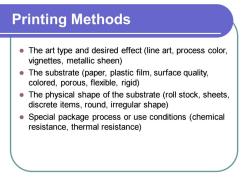
Printing Methods ⚫ The art type and desired effect (line art, process color, vignettes, metallic sheen) ⚫ The substrate (paper, plastic film, surface quality, colored, porous, flexible, rigid) ⚫ The physical shape of the substrate (roll stock, sheets, discrete items, round, irregular shape) ⚫ Special package process or use conditions (chemical resistance, thermal resistance)
Printing Methods ⚫ The art type and desired effect (line art, process color, vignettes, metallic sheen) ⚫ The substrate (paper, plastic film, surface quality, colored, porous, flexible, rigid) ⚫ The physical shape of the substrate (roll stock, sheets, discrete items, round, irregular shape) ⚫ Special package process or use conditions (chemical resistance, thermal resistance)
按次数下载不扣除下载券;
注册用户24小时内重复下载只扣除一次;
顺序:VIP每日次数-->可用次数-->下载券;
- 陕西科技大学:《包装技术基础 Fundamentals of Packaging Technology》课程PPT教学课件(英文版)Lesson 10 Graphic Design in Packaging 第10课 包装中的平面设计.ppt
- 石河子大学:《工业工程基础》课程PPT教学课件(农机专业,2012)第8章 生产率.ppt
- 石河子大学:《工业工程基础》课程PPT教学课件(农机专业,2012)第4章 工作研究概述.ppt
- 石河子大学:《工业工程基础》课程PPT教学课件(农机专业,2012)现场管理.ppt
- 石河子大学:《工业工程基础》课程PPT教学课件(农机专业,2012)第一章 工业工程概述(1.1)工业工程的发展和作用(主讲人:张慧明).ppt
- 石河子大学:《工业工程基础》课程PPT教学课件(农机专业,2012)第一章 工业工程概述(1.2)工业工程定义和内容.ppt
- 石河子大学:《工业工程基础》课程PPT教学课件(农机专业,2012)预定时间标准及模特法.ppt
- 石河子大学:《工业工程基础》课程PPT教学课件(农机专业,2012)操作分析.ppt
- 石河子大学:《工业工程基础》课程PPT教学课件(农机专业,2012)程序分析.ppt
- 石河子大学:《工业工程基础》课程PPT教学课件(机制专业,2011)第四章 工作研究概述.ppt
- 石河子大学:《工业工程基础》课程PPT教学课件(机制专业,2011)第六章 时间研究与工作抽样.ppt
- 石河子大学:《工业工程基础》课程PPT教学课件(机制专业,2011)第五章 方法研究的分析技术.ppt
- 石河子大学:《工业工程基础》课程PPT教学课件(机制专业,2011)第二章 工业工程概述2/2.ppt
- 石河子大学:《工业工程基础》课程PPT教学课件(机制专业,2011)第一章 工业工程概述1/2.ppt
- 石河子大学:《工业工程基础》课程PPT教学课件(工业专业)第4章 现场管理方法.ppt
- 石河子大学:《工业工程基础》课程PPT教学课件(工业专业)第3章 作业测定.ppt
- 石河子大学:《工业工程基础》课程PPT教学课件(工业专业)第2章 方法研究(打印版).ppt
- 石河子大学:《工业工程基础》课程PPT教学课件(工业专业)第1章 工业工程概述.ppt
- 石河子大学:《工业工程基础》课程PPT教学课件(机制专业)第八章 现场管理方法.ppt
- 石河子大学:《工业工程基础》课程PPT教学课件(机制专业)第六章 时间研究与预定时间标准.ppt
- 陕西科技大学:《包装技术基础 Fundamentals of Packaging Technology》课程PPT教学课件(英文版)Lesson 12 Shock, Vi ation, and Compression 第12课 冲击、振动和受压.ppt
- 陕西科技大学:《包装技术基础 Fundamentals of Packaging Technology》课程PPT教学课件(英文版)Lesson 13 Mechanical Shock Theory 第13课 机械冲击理论.ppt
- 陕西科技大学:《包装技术基础 Fundamentals of Packaging Technology》课程PPT教学课件(英文版)Lesson 14 Test Method for Product Fragility 第14课 产品脆值试验方法.ppt
- 陕西科技大学:《包装技术基础 Fundamentals of Packaging Technology》课程PPT教学课件(英文版)Lesson 15 Seven Steps for Cushioned Package Development 第15课 缓冲包装设计七步法.ppt
- 陕西科技大学:《包装技术基础 Fundamentals of Packaging Technology》课程PPT教学课件(英文版)Lesson 16 Distribution Packaging 第16课 运输包装.ppt
- 陕西科技大学:《包装技术基础 Fundamentals of Packaging Technology》课程PPT教学课件(英文版)Lesson 17 Computer Aided Packaging System 第17课 计算辅助包装设计系统.ppt
- 陕西科技大学:《包装技术基础 Fundamentals of Packaging Technology》课程PPT教学课件(英文版)Lesson 18 General Overview 第18课 概述.ppt
- 陕西科技大学:《包装技术基础 Fundamentals of Packaging Technology》课程PPT教学课件(英文版)Lesson 19 The Packaging Line 第19课 包装线.ppt
- 陕西科技大学:《包装技术基础 Fundamentals of Packaging Technology》课程PPT教学课件(英文版)Lesson 1 A History of Packaging 第1课 包装发展史.ppt
- 陕西科技大学:《包装技术基础 Fundamentals of Packaging Technology》课程PPT教学课件(英文版)Lesson 20 Filling Systems 第20课 充填灌装系统.ppt
- 陕西科技大学:《包装技术基础 Fundamentals of Packaging Technology》课程PPT教学课件(英文版)Lesson 2 Packaging Functions 第2课 包装的功能.ppt
- 陕西科技大学:《包装技术基础 Fundamentals of Packaging Technology》课程PPT教学课件(英文版)Lesson 3 Paper and Paperboard 第3课 纸与纸板.ppt
- 陕西科技大学:《包装技术基础 Fundamentals of Packaging Technology》课程PPT教学课件(英文版)Lesson 4 Corrugated Fiberboard Boxes 第4课 瓦楞纸板箱.ppt
- 陕西科技大学:《包装技术基础 Fundamentals of Packaging Technology》课程PPT教学课件(英文版)Lesson 5 Metal Containers 第5课 金属容器.ppt
- 陕西科技大学:《包装技术基础 Fundamentals of Packaging Technology》课程PPT教学课件(英文版)Lesson 6 Glass Containers 第6课 玻璃容器.ppt
- 陕西科技大学:《包装技术基础 Fundamentals of Packaging Technology》课程PPT教学课件(英文版)Lesson 7 Plastics in Packaging 第7课 塑料在包装中的应用.ppt
- 陕西科技大学:《包装技术基础 Fundamentals of Packaging Technology》课程PPT教学课件(英文版)Lesson 8 Flexible Packaging Laminates 第8课 软包装复合材料.ppt
- 陕西科技大学:《包装技术基础 Fundamentals of Packaging Technology》课程PPT教学课件(英文版)Lesson 9 Color 第9课 颜色.ppt
- 沈阳师范大学:《通风除尘与物料输送》课程教学课件(PPT讲稿)流体力学基础 1.1 第一节 空气在管道中流动的基本规律.ppt
- 沈阳师范大学:《通风除尘与物料输送》课程教学课件(PPT讲稿)流体力学基础 1.2 第二节 流动阻力和能量损失.ppt
